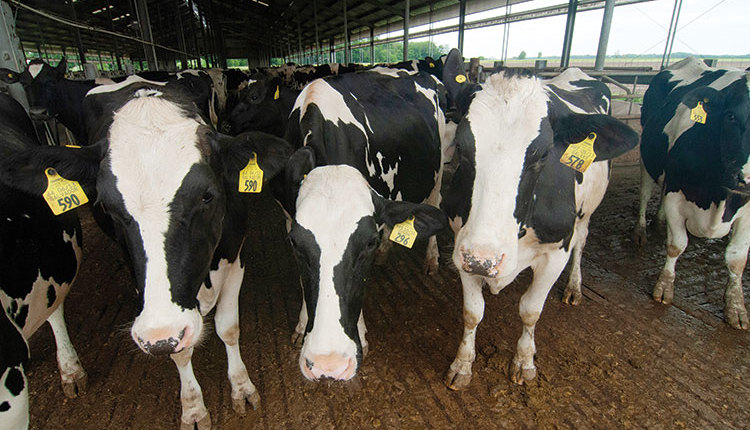The author is a professor of animal sciences at Kansas State University, Manhattan.
Those who actively manage your farm's A.I. breeding program and read my column already know that reproduction is a key factor to farm profitability. You also realize that, in many cases, reproductive performance on farms is far from optimal, even at times on your own dairy.
In 2005, a group of dairy cattle reproduction experts set out to address the issue. The group included academicians, veterinarians, dairy producers, and allied industries such as semen, pharmaceutical, and nutrition companies that organized the first Dairy Cattle Reproduction Council (DCRC) meeting. As a founding member of this organization and past chair of the program committee, I know that DCRC has strived to address unmet needs of the dairy sector in the area of reproduction.
Vision defined
The DCRC mission is to:
New technologies have become available in recent years to improve reproductive success. These technologies include improvements to traditional approaches to reproductive management (heat detection and A.I.), as well as to approaches that synchronize ovulation and estrus so all cows can be inseminated at one time (timed-A.I. programs). Combinations of traditional and timed-A.I. programs also are used on many farms. Regardless of the approach, a focused effort on reproductive management has increased pregnancy rates, translating to greater reproductive efficiency on dairy farms.

Reproduction protocols
To meet one of the DCRC vision statements, a special committee was organized and met in 2010 under the direction of our current DCRC president, Matt Lucy. The committee's goal is to formulate standard guidelines that define various tried and tested A.I. breeding protocols. Synchronization protocols evolve rapidly as newer procedures are tested and improvements are made to them.
To help veterinarians and industry professionals deal with rapid change and make informed decisions related to synchronization protocols, the DCRC has created the 2011 Dairy Cattle Synchronization Protocol sheet now available on the DCRC website (http://www.dcrcouncil.org) under Educational Resources.
The two-page document outlines established synchronization protocols that may help dairy producers improve on-farm reproductive performance. This document is intended for educational purposes as consultants work with dairy producer clients to make reproductive management decisions. The DCRC does not endorse one protocol over another; nor does DCRC endorse synchronization protocols over any of the other approaches to dairy cattle reproduction. The document will be reviewed annually by representatives from the DCRC. New protocols will be included when they are validated in controlled studies.
The document, available in English and Spanish, pictorially outlines programs for A.I. breeding at first services and repeat services for cows found open at pregnancy diagnosis. It provides product information, color-coded calendars for setting up injection schemes, and definitions. It also discusses the importance of compliance - "the right cow getting the correct hormone on the scheduled day." One example from the document is illustrated.
No specific recommendations for various programs are given because synchronization efficiency and fertility may differ among the listed programs as they are applied in different dairy operations. Programs illustrated, however, have been field-tested with adequate controls and, when applied correctly, should be reliable.
Many factors contribute to good fertility. If cows are struggling with subclinical disease, rations are not balanced properly, dry cow and transition cow facilities and health are not up to par, no A.I. breeding program will deliver good pregnancy outcomes. Work together with your dairy management team to make necessary improvements in your operation that will result in better fertility.
Those who actively manage your farm's A.I. breeding program and read my column already know that reproduction is a key factor to farm profitability. You also realize that, in many cases, reproductive performance on farms is far from optimal, even at times on your own dairy.
In 2005, a group of dairy cattle reproduction experts set out to address the issue. The group included academicians, veterinarians, dairy producers, and allied industries such as semen, pharmaceutical, and nutrition companies that organized the first Dairy Cattle Reproduction Council (DCRC) meeting. As a founding member of this organization and past chair of the program committee, I know that DCRC has strived to address unmet needs of the dairy sector in the area of reproduction.
Vision defined
The DCRC mission is to:
- Be a noncommercial, science-based organization whose main goal is to promote the development and adoption of reproductive technologies.
- Be open to all sectors in the dairy industry with an interest in dairy cattle reproduction. It will be an inclusive organization with the responsibility to reach out to several sectors of the dairy industry.
- Aim to become the primary source of information and technology regarding reproductive management and become a conduit of information relative to integrated management considerations.
- Adopt a common terminology, identify key parameters and minimum goals for evaluation of reproductive performance, and provide educational material for reference.
- Identify the critical areas for technology development and transfer.
- Hold national and/or regional meetings to disseminate information to the industry.
The DCRC welcomes all who wish to contribute to and become members of the organization and urges individuals to assume leadership responsibilities.
New technologies have become available in recent years to improve reproductive success. These technologies include improvements to traditional approaches to reproductive management (heat detection and A.I.), as well as to approaches that synchronize ovulation and estrus so all cows can be inseminated at one time (timed-A.I. programs). Combinations of traditional and timed-A.I. programs also are used on many farms. Regardless of the approach, a focused effort on reproductive management has increased pregnancy rates, translating to greater reproductive efficiency on dairy farms.

Reproduction protocols
To meet one of the DCRC vision statements, a special committee was organized and met in 2010 under the direction of our current DCRC president, Matt Lucy. The committee's goal is to formulate standard guidelines that define various tried and tested A.I. breeding protocols. Synchronization protocols evolve rapidly as newer procedures are tested and improvements are made to them.
To help veterinarians and industry professionals deal with rapid change and make informed decisions related to synchronization protocols, the DCRC has created the 2011 Dairy Cattle Synchronization Protocol sheet now available on the DCRC website (http://www.dcrcouncil.org) under Educational Resources.
The two-page document outlines established synchronization protocols that may help dairy producers improve on-farm reproductive performance. This document is intended for educational purposes as consultants work with dairy producer clients to make reproductive management decisions. The DCRC does not endorse one protocol over another; nor does DCRC endorse synchronization protocols over any of the other approaches to dairy cattle reproduction. The document will be reviewed annually by representatives from the DCRC. New protocols will be included when they are validated in controlled studies.
The document, available in English and Spanish, pictorially outlines programs for A.I. breeding at first services and repeat services for cows found open at pregnancy diagnosis. It provides product information, color-coded calendars for setting up injection schemes, and definitions. It also discusses the importance of compliance - "the right cow getting the correct hormone on the scheduled day." One example from the document is illustrated.
No specific recommendations for various programs are given because synchronization efficiency and fertility may differ among the listed programs as they are applied in different dairy operations. Programs illustrated, however, have been field-tested with adequate controls and, when applied correctly, should be reliable.
Many factors contribute to good fertility. If cows are struggling with subclinical disease, rations are not balanced properly, dry cow and transition cow facilities and health are not up to par, no A.I. breeding program will deliver good pregnancy outcomes. Work together with your dairy management team to make necessary improvements in your operation that will result in better fertility.










